Number of constructions increased in Cebu
The total number of constructions from approved building permits in Cebu province for the second quarter of 2021 reached to 2,134. This number is five times more than the total number of constructions at 345 of the same quarter in 2020. (See Table 1)
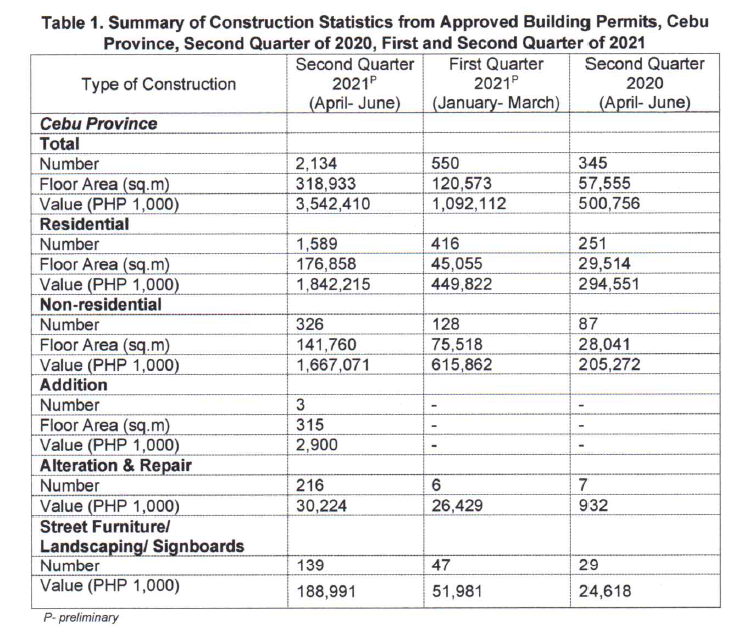
Residential had the highest number of constructions
By type of construction, residential reported the highest number of constructions in the second quarter of 2021 at 1,589 or 74.46% of the total number of constructions in Cebu province. This was followed by non-residential with 326 or 15.28% and alteration and repair with 216 or 10.12% from the total number of constructions in the province. The type of construction with the least number of constructions reported was the Addition at 3 or 0.14% from the total number of constructions.
(See Table 1)
Majority of residential construction are single houses
Of the 1,589 residential constructions, 1,205 or 75.83% are single houses. This was followed by apartment/accesoria with 377 or 23.73%, duplex/quadruplex houses and other residential constructions with 3 each or 0.19%, and 1 residential condominium or 0.06% from the total residential constructions. (See Figure 1)
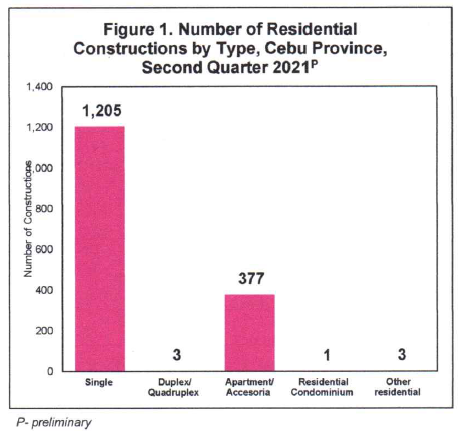
Majority of non-residential constructions are commercial buildings
Among non-residential constructions, 76.99% or 251 are commercial buildings, this was followed by industrial buildings with 39 or 11.96%, institutional buildings with 29 or 8.89% and agricultural buildings with 7 or 2.15% from the number of total non-residential constructions. (See Figure 2)
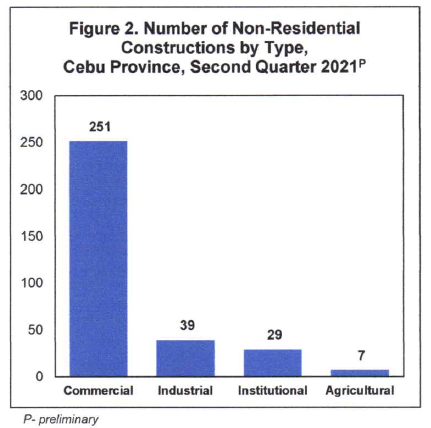
Value of Constructions
Total value of constructions in Cebu increased up to 3.5 billion
In the second quarter of 2021, the total value of constructions in Cebu province reached to PhP 3.5 billion which represents an annual increase of six times more than the total value of constructions from the second quarter in 2020 at PhP 500 million. Value of constructions in the same period also raised by twice the value of constructions in the first quarter in 2021 at PhP 1 billion. (See Table 1)
Residential recorded the highest value of constructions
Residential building constructions valued at PhP 1.8 billion this accounted to 52% of the total value of constructions in the second quarter of 2021 in Cebu province. The construction value of residential constructions is five times more than the value of constructions of the same period in 2020 at PhP 294 million. (See Table 1)
Meanwhile, value of non-residential constructions which amounted to PhP 1.67 billion, accounted for 47% of the total value during the quarter. This translates to an annual increase of seven times higher than the value of non-residential constructions of the same period in 2020. (See Table 1)
For this quarter, the value of construction for addition and alteration to existing structures amounted to PhP 2.9 million (0.08%) and PhP 30.2 million (0.8%) respectively. Alteration and repair constructions posted an increased of PhP 29.29 million from the value of construction in the second quarter of 2020 at PhP 932 thousand. (See Table 1)
Highest value of construction in Single houses
Single houses posted the highest value of construction among residential type of construction with PhP 1.34 billion or 72.5% from the total value of residential construction. This was followed by apartment/ accesoria type of construction and residential condominium with PhP 455 million or 24.7%, and PhP 37 million or 2% respectively. Other residential type of construction and duplex houses combines PhP 13 million or 0.7% value of construction from the residential constructions. (See Figure 3)
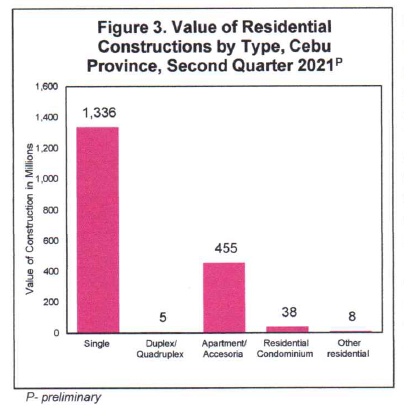
Industrial buildings had the highest value of construction among non-residential
Among non-residential type of constructions, Industrial buildings had the highest value of construction with PhP 920 million or 55.2%. This was followed by Commercial buildings and Institutional buildings with PhP 452 million or 27.1% and PhP 253 million or 15.2% respectively. The lowest value among non-residential type of constructions is the agricultural buildings with PhP 41 million or 2.5% from the total value of non-residential construction. (See Figure 4)
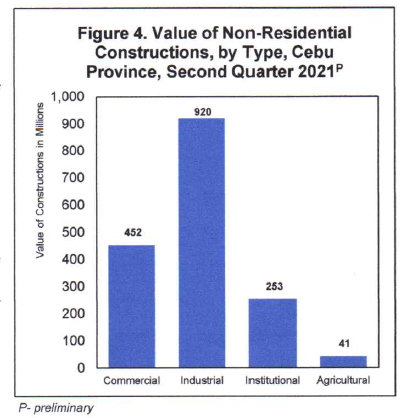
Floor Area
Reported total floor area of constructions further expanded
The total floor area of constructions for the second quarter 2021 in Cebu Province further increased to 318,933 square meters, translating to an annual increase of 454% and an increase of 164% from the previous quarter in 2021. (See Table 1)
Residential accounted for more than half of the total floor area of constructions
Residential constructions recorded a floor area of 176,858 square meters or 55.5% of the total floor area of constructions in second quarter 2021 in Cebu province. It increased at an annual rate of four times higher than the floor area in 2020. Furthermore, non-residential constructions floor area further increased to 141,760 square meters, this is 405% higher than the second quarter in 2020. (See Table 1)

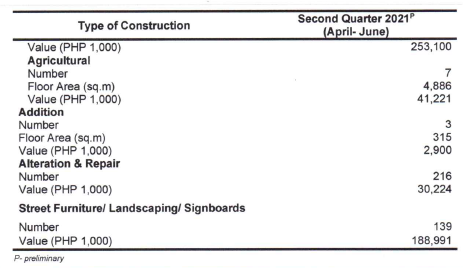
TECHNICAL NOTES
Introduction
This Special Release presents the preliminary data on construction statistics from approved building permits for the second quarter of 2021. Data are presented at the regional and provincial levels with monthly disaggregation.
Scope and Coverage
Construction statistics presented in this special release are based on the approved building permits on new constructions and additions, alterations and repairs of existing residential and non-residential buildings, and other structures which are proposed to be constructed in the different cities/municipalities of the country.
Sources of Information
Construction statistics are generated from approved building permits as well as from the demolition and fencing permits collected every month by the Philippine Statistics Authority (PSA) field personnel from the Offices of Local Building Officials (LBOs).
Limitations of data
Data on building constructions are based on approved applications for construction during the reference period and not on the construction work completed during the reference period.
The completeness of construction data relies on the approved applications filed with the LBOs. Hence, building constructions without approved building permits are not part of the tabulation of data.
Geographic Classification
For the second quarter of 2021, building constructions are classified and presented by geographic area using the Philippine Standard Geographic Classification (PSGC) as of December 2017.
Statistics Generated
Construction statistics generated from approved building permits provide monthly data on building construction at the regional and provincial level. The statistics generated are the following:
- number
- floor area
- type of construction
- value of construction
Aside from the preliminary tables posted in the PSA website, the annual, quarterly, and monthly statistical tables at the municipality level by type of construction are available at the Industry Statistics Division (ISD) of the Economic Sector Statistics Service (ESSS) of the PSA. They can be requested through email at nonmfg.staff@psa.gov.ph.
Dissemination
Preliminary results of construction statistics are made public in the form of Quarterly Special Releases. The Quarterly Special Releases are reports containing the preliminary results of construction statistics submitted within the cut-off dates for each month. Results are posted 65 days after the reference quarter in the PSA website (www.psa.gov.ph).
Revision
All documents received after the cut-off date, which is 40 days after the reference quarter, are included in the generation of the revised results. The revised data of the previous quarter are reported during the release of the preliminary report of the current quarter. Revisions are made for the previous quarters until the annual report is released seven months after the reference year.
Definition of Terms (Adopted from the Revised and Updated IRR of the National Building Code)
Building permit is a written authorization granted by the LBO to an applicant allowing him to proceed with the construction of a specific project after plans, specifications, and other pertinent documents have been found to be in conformity with the National Building Code (PD 1096).
Building refers to any independent, free-standing structure comprised of one or more rooms or other spaces, covered by a roof and enclosed with external walls or dividing walls, which extend from the foundation to the roof.
Construction refers to all on-site work done from site preparation, excavation, foundation, assembly of all the components and installation of utilities, machineries, and equipment of buildings/structures.
Residential building is a building for which its major parts or more than half of its gross floor area is built for dwelling purposes. This type of building can be of the single type, duplex, apartment and/or accessoria, and residential condominium.
Single house is a complete structure intended for a single family or household, i.e., bungalow, 2-storey house, nipa hut, etc.
Duplex house is a structure intended for two households, with complete living facilities for each; it is a single structure divided into two dwelling units by a wall extending from the floor to the ceiling.
Apartment is a structure, usually of two storeys, made up of independent living quarters, with independent entrances from internal walls and courts.
Accesoria is a one or two-floor structure divided into several dwelling units, each dwelling unit having its own separate entrance from the outside.
Residential condominium is a structure, usually of several storeys, consisting of multiple dwelling units.
Other residential construction consists of school or company staff houses, living quarters for drivers and maids, and guardhouses.
Non-residential building includes commercial, industrial, agricultural, and institutional buildings.
Commercial buildings refer to office buildings and all buildings which are intended for use primarily in wholesale, retail and service trades; i.e., stores, hotels, restaurants, banks, disco houses, etc.
Industrial buildings are buildings used to house the production, assembly, and warehousing activities of industrial establishments; i.e., factories, plants, mills, repair shops, machine shops, printing press, storage plant, electric generating plants.
Institutional buildings are buildings which primarily engaged in providing educational instructions and hospital/health care; ports, airports and other government buildings; i.e., school, museums, libraries, sanitaria, churches, and hospitals.
Agricultural buildings are buildings used to house livestock, plants, and agricultural products such as barn, poultry house, piggeries, stables, greenhouses, and grain mill.
Other non-building constructions include cemetery structures, street furniture, waiting sheds, communication towers, etc.
Addition refers to any new construction which increases the height or area of an existing building/structure.
Repair is a remedial work done on any damaged or deteriorated portion/s of a building/structure to restore its original condition.
Renovation is any physical change made on structures to increase their value and quality.
Alteration is a construction in a building/structure involving changes in the materials used, partitioning and location/size of openings, structural parts, existing utilities and equipment but does not increase the overall area thereof.
Conversion is a change in the use or occupancy of structure or any portion thereof, which has different requirements.
Demolitions refer to the systematic dismantling or destruction of a building/structure, in whole or in part.
Street furniture are street structures consisting of monuments, waiting sheds, benches, plant boxes, lampposts, electric poles, and telephone poles.
Floor area of building refers to the sum of the area of each floor of the building measured to the outer surface of the outer walls including the area of lobbies, cellars, elevator shafts and all communal spaces in multi dwellings. Areas of balconies are excluded.
Total value of construction refers to the sum of the cost of building, electrical, mechanical, plumbing, and others. The value is derived from the approved building permit and represents the estimated value of the building or structure when completed.
(SGD) FIRMO C. DIPUTADO
Chief Statistical Specialist

